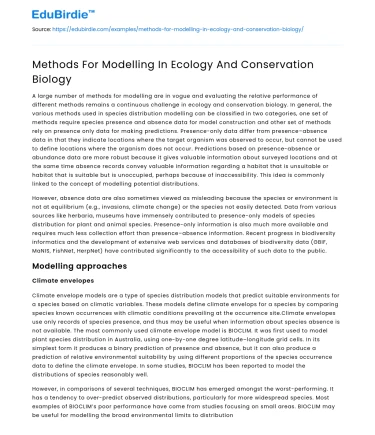A large number of methods for modelling are in vogue and evaluating the relative performance of different methods remains a continuous challenge in ecology and conservation biology. In general, the various methods used in species distribution modelling can be classified in two categories, one set of methods require species presence and absence data for model construction and other set of methods rely on presence only data for making predictions. Presence-only data differ from presence–absence data in that they indicate locations where the target organism was observed to occur, but cannot be used to define locations where the organism does not occur. Predictions based on presence-absence or abundance data are more robust because it gives valuable information about surveyed locations and at the same time absence records convey valuable information regarding a habitat that is unsuitable or habitat that is suitable but is unoccupied, perhaps because of inaccessibility. This idea is commonly linked to the concept of modelling potential distributions.
However, absence data are also sometimes viewed as misleading because the species or environment is not at equilibrium (e.g., invasions, climate change) or the species not easily detected. Data from various sources like herbaria, museums have immensely contributed to presence-only models of species distribution for plant and animal species. Presence-only information is also much more available and requires much less collection effort than presence–absence information. Recent progress in biodiversity informatics and the development of extensive web services and databases of biodiversity data (GBIF, MaNIS, FishNet, HerpNet) have contributed significantly to the accessibility of such data to the public.
Save your time!
We can take care of your essay
- Proper editing and formatting
- Free revision, title page, and bibliography
- Flexible prices and money-back guarantee
Modelling approaches
Climate envelopes
Climate envelope models are a type of species distribution models that predict suitable environments for a species based on climatic variables. These models define climate envelops for a species by comparing species known occurrences with climatic conditions prevailing at the occurrence site.Climate envelopes use only records of species presence, and thus may be useful when information about species absence is not available. The most commonly used climate envelope model is BIOCLIM. It was first used to model plant species distribution in Australia, using one-by-one degree latitude–longitude grid cells. In its simplest form it produces a binary prediction of presence and absence, but it can also produce a prediction of relative environmental suitability by using different proportions of the species occurrence data to define the climate envelope. In some studies, BIOCLIM has been reported to model the distributions of species reasonably well.
However, in comparisons of several techniques, BIOCLIM has emerged amongst the worst-performing. It has a tendency to over-predict observed distributions, particularly for more widespread species. Most examples of BIOCLIM’s poor performance have come from studies focusing on small areas. BIOCLIM may be useful for modelling the broad environmental limits to distributions over very large study areas. DOMAIN is a better performing technique as compared to BIOCLIM and has been shown to overcome some of the problems of over-prediction associated with BIOCLIM. In comparison of modelling techniques its performance has been generally intermediate, although relatively better than other techniques with very small number of presence records.
Logistic regression
Logistic regression modeling techiniques model species distributions as a binomial response against climate predictors.Among various logistic regression modeling techiniques‘General Linear Models’ (GLMs) have been used widely to predict the distribution of species because the model outputs are easy to interpret and also the software is available freely. GLMs have generally performed very well in comparisons of different modelling techniques, although relatively poorly with very small sample sizes. The second category of logistic regression modelling techiniques is ‘Generalized Additive Models’ (GAMs). GAMs have also performed very well in published studies, and often somewhat better than GLMs, although they are even more sensitive to small sample sizes. As with GLMs, the software is freely available and relatively easy to use, but the output is not easy to interpret.
Maximum Entropy Method (Maxent)
Phillips et al., (2006) introduced the use of the maximum entropy method (MaxEnt) for modelling species geographic distributions with presence-only data. MaxEnt is a general-purpose machine learning method with a simple and precise mathematical formulation, and it has a number of aspects that make it well-suited for species distribution modelling. In MaxEnt, one is given a set of samples from a distribution over some space, as well as a set of features on this space. The idea of MaxEnt is to estimate the target distribution by finding the distribution of maximum entropy. For species distribution modelling, the occurrence localities of the species serve as the sample points, the geographical region of interest is the space on which this distribution is defined, and the features are the environmental variables. Maximum-entropy is quite useful for modelling species geographic distributions, a critical problem in conservation biology and is currently one of the most popular methods used in species distribution modelling.
The models generated by MaxEnt have a natural probabilistic interpretation, giving a smooth gradation from most to least suitable conditions. It has also shown that the models can be easily interpreted by experts, a property of great practical importance. Other advantages of Maxent include:
- it works on presence only data and does not require data on species absence.
- the predictive power of maxent has been proven to outperform other modelling methods.
- it can utilize both continuous and categorical data, and can incorporate interactions between different variables.
- the Maxent probability distribution has a concise mathematical definition, and is therefore amenable to analysis.
- over-fitting can be avoided by using regularization.
- the output is continuous, allowing fine distinctions to be made between the modelled suitability of different areas.






 Stuck on your essay?
Stuck on your essay?

